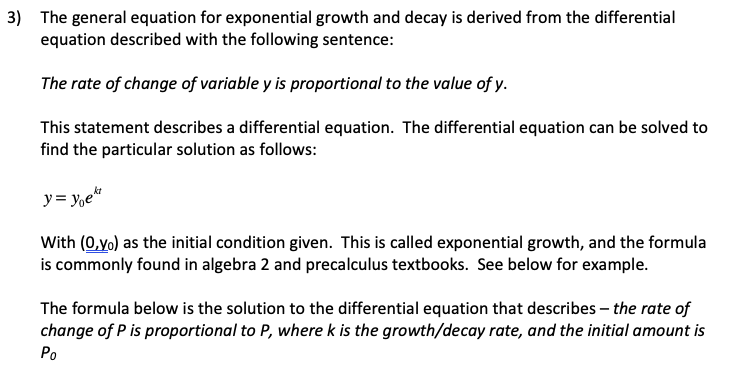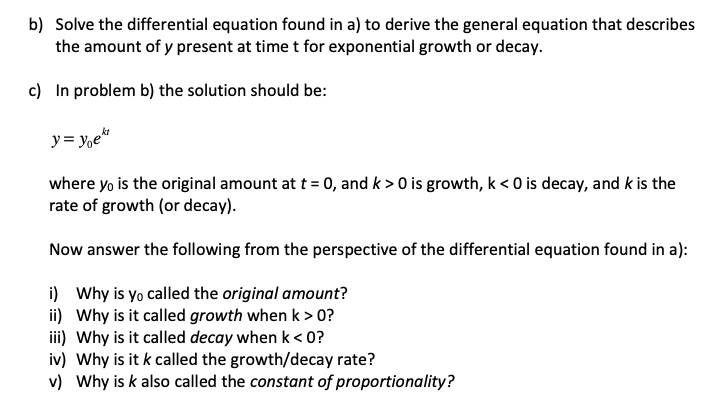b) Solve the differential equation found in a) to derive the general equation that describes the amount of y present at time t for exponential growth or decay. c) In problem b) the solution should be: y = y,e where yo is the original amount at t = 0, and k > 0 is growth, k < 0 is decay, and k is the rate of growth (or decay). Now answer the following from the perspective of the differential equation found in a): i) Why is yo called the original amount? ii) Why is it called growth when k > 0? i) Why is it called decay when k < 0? iv) Why is it k called the growth/decay rate? v) Why is k also called the constant of proportionality?
b) Solve the differential equation found in a) to derive the general equation that describes the amount of y present at time t for exponential growth or decay. c) In problem b) the solution should be: y = y,e where yo is the original amount at t = 0, and k > 0 is growth, k < 0 is decay, and k is the rate of growth (or decay). Now answer the following from the perspective of the differential equation found in a): i) Why is yo called the original amount? ii) Why is it called growth when k > 0? i) Why is it called decay when k < 0? iv) Why is it k called the growth/decay rate? v) Why is k also called the constant of proportionality?
Calculus: Early Transcendentals
8th Edition
ISBN:9781285741550
Author:James Stewart
Publisher:James Stewart
Chapter1: Functions And Models
Section: Chapter Questions
Problem 1RCC: (a) What is a function? What are its domain and range? (b) What is the graph of a function? (c) How...
Related questions
Question
100%

Transcribed Image Text:3) The general equation for exponential growth and decay is derived from the differential
equation described with the following sentence:
The rate of change of variable y is proportional to the value of y.
This statement describes a differential equation. The differential equation can be solved to
find the particular solution as follows:
y= y,e*
With (0,yo) as the initial condition given. This is called exponential growth, and the formula
is commonly found in algebra 2 and precalculus textbooks. See below for example.
The formula below is the solution to the differential equation that describes – the rate of
change of P is proportional to P, where k is the growth/decay rate, and the initial amount is
Po

Transcribed Image Text:b) Solve the differential equation found in a) to derive the general equation that describes
the amount of y present at time t for exponential growth or decay.
c) In problem b) the solution should be:
y= y,e*
where yo is the original amount at t = 0, and k >0 is growth, k< 0 is decay, and k is the
rate of growth (or decay).
Now answer the following from the perspective of the differential equation found in a):
i) Why is yo called the original amount?
ii) Why is it called growth when k > 0?
iii) Why is it called decay when k< 0?
iv) Why is it k called the growth/decay rate?
v) Why is k also called the constant of proportionality?
Expert Solution
This question has been solved!
Explore an expertly crafted, step-by-step solution for a thorough understanding of key concepts.
Step by step
Solved in 4 steps

Knowledge Booster
Learn more about
Need a deep-dive on the concept behind this application? Look no further. Learn more about this topic, calculus and related others by exploring similar questions and additional content below.Recommended textbooks for you

Calculus: Early Transcendentals
Calculus
ISBN:
9781285741550
Author:
James Stewart
Publisher:
Cengage Learning

Thomas' Calculus (14th Edition)
Calculus
ISBN:
9780134438986
Author:
Joel R. Hass, Christopher E. Heil, Maurice D. Weir
Publisher:
PEARSON

Calculus: Early Transcendentals (3rd Edition)
Calculus
ISBN:
9780134763644
Author:
William L. Briggs, Lyle Cochran, Bernard Gillett, Eric Schulz
Publisher:
PEARSON

Calculus: Early Transcendentals
Calculus
ISBN:
9781285741550
Author:
James Stewart
Publisher:
Cengage Learning

Thomas' Calculus (14th Edition)
Calculus
ISBN:
9780134438986
Author:
Joel R. Hass, Christopher E. Heil, Maurice D. Weir
Publisher:
PEARSON

Calculus: Early Transcendentals (3rd Edition)
Calculus
ISBN:
9780134763644
Author:
William L. Briggs, Lyle Cochran, Bernard Gillett, Eric Schulz
Publisher:
PEARSON

Calculus: Early Transcendentals
Calculus
ISBN:
9781319050740
Author:
Jon Rogawski, Colin Adams, Robert Franzosa
Publisher:
W. H. Freeman


Calculus: Early Transcendental Functions
Calculus
ISBN:
9781337552516
Author:
Ron Larson, Bruce H. Edwards
Publisher:
Cengage Learning